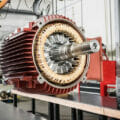After successfully participating in a collaborative research and development competition organised by the government-backed Advanced Propulsion Centre UK (APC), Deregallera, a subsidiary of DGI plc, has won funding for Cap-Size, a six-month project to evaluate large-scale manufacturing options for a novel material that will significantly reduce the environmental impact of batteries used in electric vehicles.
Cap-Size (Capital Investment in an Anode Manufacturing Plant – a Sizing Study) builds on Deregallera’s achievements, in conjunction with AMTE Power plc, in pilot-scale manufacturing of batteries using the new material.
Deregallera is an advanced research and development organisation dedicated to innovation in energy storage and drive systems for future generations of electric vehicles. The company has developed a ground-breaking process that produces anode material for use in electric vehicle batteries from readily available bio-waste. This eliminates the large environmental impact of the graphite normally used for this purpose, as well as making productive use of bio-waste that would otherwise go to landfill.
“APC estimates that, by 2030, the UK will require 90 GWh of battery cells every year, just for EV’s. Which equates to a demand for approximately 100,000 tonnes of graphite, every year. With that figure set to continue growing throughout the middle of the century.” said Peter Curran of Deregallera. “Graphite either comes from limited fossil resources or is a by-product of oil-refining and so sourcing this quantity annually would have a huge environmental impact. Our new material solves this problem as it replaces graphite and has minimal environmental impact. Furthermore, the whole supply chain will reside within the UK, whereas graphite would rely on a complex multi-national supply chain involving 100,000s of tonnes of materials criss-crossing the globe.”
Deregallera has already developed a business case, including detailed analysis of capital and running costs, for a plant capable of producing up to 500 tonnes per year of the new anode material. With the additional funding from APC, this business case will be extended to embrace plants with capacity up to 10,000 tonnes per annum. Factors to be considered will include optimum plant size and quantifying the carbon footprint of producing the new material compared with that of existing materials.








